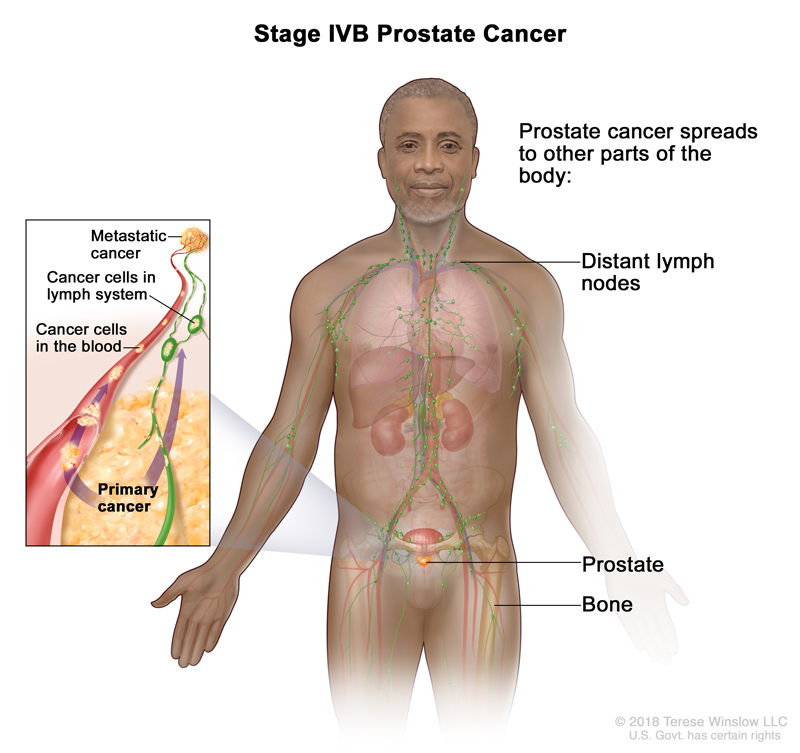Overview
Stage 4 Prostate Cancer is a late stage of Prostate Cancer, also referred to as Metastatic Prostate Cancer.
Understanding your Metastatic Prostate Cancer diagnosis will help you and your doctors make the best treatment choice for you. Tap “Watch Now” for an easy-to-understand overview of Stage 4 Prostate Cancer.
- Metastatic Prostate Cancer Diagnosis
- Gleason Score & PSA Explained
Overview
A Stage 4B or Metastatic Prostate Cancer diagnosis means that the tumor has spread to your lymph nodes outside the pelvis or to other organs in your body, most commonly to the bones.
What Tests Will I Need and Why?
Blood and Imaging tests are done to understand your general health, confirm your diagnosis and determine your cancer stage.
Tissue Analysis is done to identify the cancer cell type and the Gleason Score, which is critical to finding the best treatment option for you.
In addition, your doctors will determine if your tumor is Castration Naive/Sensitive or Castration Resistant to come up with treatment options that are suitable for your specific Prostate Cancer type.
Castration Naive or Castration Sensitive Prostate Cancer is used to describe patients who have not been treated with Androgen Deprivation Therapy (ADT) previously or are not on an ADT at the time of progression or relapse.
Castration Resistant Prostate Cancer is used to define patients who have failed to respond to ADT (PSA elevation or new tumors on imaging tests during ADT treatment).
You may also require special Saliva or Blood Analysis to look for specific mutations (actual changes in your body’s DNA), called BRCA1 and BRCA2.
Re-read this summary as needed and then tap, “Compare My Treatment Options Now“. Our unique Comparison Page will help you understand your FDA-approved treatment options including, who can help you pay for your treatment, where and how each is given and what side-effects you may experience.

Cancer Research U.K. CC BY-SA 4
Gleason Score & PSA Density
A Prostate Cancer diagnosis is based upon the results of staging and two tests called the Gleason Score and the Prostate-Specific Antigen (PSA) tests
Finding Your Gleason Score
Samples of your cancer cells are examined to find out your Gleason Score. A Gleason Score, which will range between 2 and 10, describes how aggressive a prostate tumor is by looking at how similar or different the cancer cells look to healthy cells.
The Gleason Score is made up of 2 grades that range from 1 to 5. A low grade of 1 means that the cells in the tumor look very much like healthy prostate cells. Cells that look completely different to normal cells are assigned a higher score, usually 4 or 5.
- The first grade is given to describe the cells in the largest area of the tumor
- The second grade is given to describe the cells in the second largest area of the tumor.
When these two grades are added together, they give us a Gleason Score between 2 and 10. For example, 3+4 = Gleason Score 7.
Prostate-Specific Antigen (PSA) tests
Your Dr. also measures PSA Density to help determine the aggressiveness of the prostate cancer found. PSA Density is your PSA level, divided by the volume of the prostate gland.
A high PSA density is often a predictor of Prostate Cancer but please discuss your specific situation with your doctors.
Recommended Prostate Cancer Videos

Prostate Cancer
An Overview

Understanding Localized Prostate Cancer
An Overview

A Diagnosis and Treatment: Localized Prostate Cancer
A Conversation with Dr. John Lynch

Exercise & Prostate Cancer
From Your Friends @ the Oncology Nursing Society

How Cancer Spreads
Metastatic = Advanced
Commonly Searched Questions
What is the Survival Rate for Metastatic Prostate Cancer?
According to SEER data, Metastatic Prostate Cancer has a survival rate of 31%. For example, if the 5-year relative survival rate for the metastatic prostate cancer is 31%, it means that patients who have that cancer are, on average, about 31% as likely as patients who don’t have that cancer to live for at least 5 years after being diagnosed.
Source: Cancer.gov
What is the ICD10 for Metastatic Prostate Cancer?
ICD-10 is code C61 for Malignant neoplasm of prostate is a medical classification as listed by WHO under the range – Malignant neoplasms.
Source: Aapc.com
What are the treatment options for Metastatic Prostate Cancer?
Advanced prostate cancer occurs when a tumor that develops in the prostate gland spreads outside the prostate. The most common sites of prostate cancer spread are to the lymph nodes and bones. This is also called metastatic prostate cancer. Currently, no treatments can cure advanced/metastatic prostate cancer. However, there are effective ways to help slow its spread, prolong life, and control its symptoms, including immunotherapy, hormone therapy, chemotherapy, precision medicine and clinical trials.
Source: Uclahealth.org
What is the most frequently affected organ by Metastatic Prostate Cancer?
Most often, prostate cancer spreads to the bones or lymph nodes. It’s also common for it to spread to the liver or lungs. It’s rare for it to move to other organs, such as the brain, but that can happen.
Source: Webmd.com
What are the symptoms for Metastatic Prostate Cancer?
Signs and symptoms of metastatic prostate cancer may include:
- Painful urination
- Decreased force in the stream of urine
- Blood in the semen
- Bone pain
- Swelling in the legs
- Fatigue
Source: Mayoclinic.org















